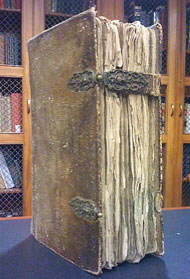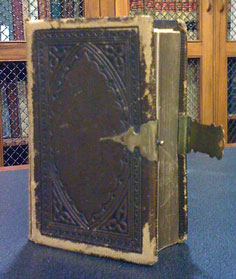
Book Clasps on three different book
Among the things people have done to decorate books over the years, putting clasps on them is one of the more uncommon today, but historically was pretty popular.
Clasps made sense in the beginning. Books were made from vellum, a dried animal skin, which reacted poorly to changes in humidity. As it dried out, vellum would warp and wrinkle. Heavy clasps on books helped keep them closed while the vellum pages shifted and protected the books from splaying wide open. Or at least, that's one theory. The truth is, we'll probably never know exactly why people stuck clasps on books in the beginning, but clasps were quite popular.
Once paper became the primary material for book pages, replacing vellum, the clasps were used to relieve strain on the binding and helped hold the book closed. In England and France, the clasp was on the cover and the catch on the back, but in the rest of Europe the positions were reversed. Since books were stacked up, rather than placed on shelves at the time, the clasps didn't pose a problem.
When people began shelving books side by side, as we do today, the problems with clasps began. Not only did clasps rub and dig into neighboring books, often damaging them, but they couldn't be seen and the pressure from the surrounding books on the shelves was usually enough to keep books closed, rendering clasps obsolete.
In the 17th century, clasps were falling out of fashion. By the 18th century, they were practically non-existent, except on very large books. By the days of the Civil War, clasps were entirely decorative, their original purpose long forgotten.
Clasps can be seen on religious books, diaries, and sometimes on photo albums today, mostly because they look pretty, but never on a popular novel or text book.
Rachel Cohen is a former User Engagement Special Collection Librarian for Samford University Library.
Resources
- Arndt, Johann. Postille: das ist, Geist-reiche Erklarung der Evangelischen Texte durchs gantze Jahr, aufs alle Sonn-hohe und andere fest- und Apostel-Tage, sampt einer durchgehenden Betrachtung über die gantze Passions-Historie. Franckfurt: Verlegt von Joh. David Zunners, sel. Erben und J.A. Jungen, 1713.
- Carter, John. ABC for Book-Collectors. New York: Alfred A. Knopf, 1970.
- Curry, JLM. Photograph Album. SC Collection Number: SC 186
- Manly, Basil, and B. Manly. The Baptist Psalmody: A Selection of Hymns for the Worship of God. Philadelphia: J.B. Lippincott, 1870.





